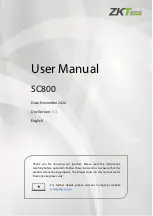
• FET Overtemperature Protection
• Precharge Timeout Protection
• Host Watchdog Fault Protection
11.3 Secondary Protections
The BQ769142 device integrates a suite of secondary protection checks on battery operation and status that can
trigger a Permanent Fail (PF) if conditions are considered so serious that the pack should be permanently
disabled. The various PF checks can be enabled individually based on configuration settings, along with
associated thresholds and delays for most checks. When a Permanent Fail has occurred, the BQ769142 device
can be configured to either simply provide a flag, or to indefinitely disable the protection FETs, or to assert the
FUSE pin to permanently disable the pack. The FUSE pin can be used to blow an in-line fuse and also can
monitor if a separate secondary protector IC has attempted to blow the fuse.
Since the device stores Permanent Fail status in RAM, that status would be lost when the device resets. To
mitigate this, the device can write Permanent Fail status to OTP based on configuration setting. OTP
programming may be delayed in low-voltage and high-temperature conditions until OTP programming can
reliably be accomplished.
Normally, a Permanent Fail causes the FETs to remain off indefinitely and the fuse may be blown. In that
situation, no further action would be taken on further monitoring operations, and charging would no longer be
possible. To avoid rapidly draining the battery, the device may be configured to enter DEEPSLEEP mode when a
Permanent Fail occurs. Entrance to DEEPSLEEP mode will still be delayed until after fuse blow and OTP
programming are completed, if those options are enabled.
When a Permanent Fail occurs, the device may be configured to either turn the REG1 and REG2 LDOs off, or to
leave them in their present state. Once disabled, they may still be reenabled through command.
The Permanent Fail checks incorporate a programmable delay to avoid triggering a PF fault on an intermittent
condition or measurement. When the threshold is first detected as being met or exceeded by an enabled PF
check, the device will set a PF Alert signal, which can be monitored using commands and can also trigger an
interrupt on the ALERT pin.
Note
The device only evaluates the conditions for Permanent Fail at one second intervals while in NORMAL
and SLEEP modes, it does not continuously compare measurements to the Permanent Fail fault
thresholds between intervals. Thus, it is possible for a condition to trigger a PF alert if detected over
threshold, but even if the condition drops back below threshold briefly between the one second
interval checks, the PF alert would not be cleared until it was detected below threshold at a periodic
check.
For more details on the Permanent Fail checks implemented in the BQ769142, refer to the
. The secondary protection checks include:
• Safety Cell Undervoltage Permanent Fail
• Safety Cell Overvoltage Permanent Fail
• Safety Overcurrent in Charge Permanent Fail
• Safety Overcurrent in Discharge Permanent Fail
• Safety Overtemperature Permanent Fail
• Safety Overtemperature FET Permanent Fail
• Copper Deposition Permanent Fail
• Short Circuit in Discharge Latch Permanent Fail
• Voltage Imbalance Active Permanent Fail
• Voltage Imbalance at Rest Permanent Fail
SLUSE91A – SEPTEMBER 2020 – REVISED FEBRUARY 2021
Copyright © 2021 Texas Instruments Incorporated
41
Product Folder Links:
Содержание BQ769142
Страница 79: ......
















































